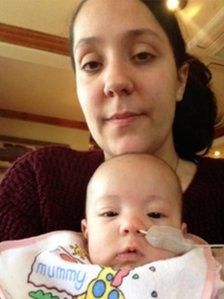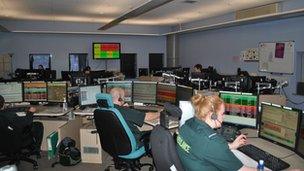Ambulance 'postcode lottery could cost 2,500 lives a year'
- Published
Amy Carter and Scott Hellings lost their daughter last year
A postcode lottery among England's 12 ambulance services could be costing 2,500 lives a year, a former ambulance service chief executive claims.
Roger Thayne believes ambulance crew delays could be a major factor.
Figures obtained by the BBC also indicate a significant variance in the performance of the country's 12 ambulance services.
The figures show the number of resuscitation attempts performed by ambulance services.
When adjusted for population, they show that the top ambulance service could be attempting to resuscitate three-and-a-half times as many cardiac arrest patients as the ambulance service at the bottom of the table.
'Absolutely frightening'
Mr Thayne, a former chief executive of the Staffordshire ambulance service, says the figures expose a health scandal and claims ambulance crews should be saving around 2,500 more lives a year.
He has called for an inquiry into why some ambulance services appear to be performing better than others.

Amy Carter is taking legal action over a delay that led to the death of her daughter Bella last year
He said: "It's absolutely frightening and totally unnecessary. We have an NHS which should be as good in any part of the country and we should not have a postcode lottery in terms of this very acute condition, the cardiac arrest.
"I estimate that we should be saving twice as many lives a year, or around 2,500 people."
Mr Thayne said he based his estimation on the performance of the South Western Ambulance Service NHS Foundation Trust together with the 40% survival rate for cardiac arrest sufferers in the top 50 hospitals.
He said the factors for failure could include slow response times, different medical procedures at the scene and the availability of defibrillators.
Mr Thayne also accused the government of publishing "misleading" figures on ambulance performance, particularly with regard to survival of cardiac arrest patients.
Currently statistics show survival rates but not the number of attempted resuscitations. He argues that if more crews arrived in time or were equipped to carry out resuscitations, more people would survive.
'Poorer performers, more survivals'
Mr Thayne added: "When these figures first came out in the middle of 2011-12, when I saw those figures, I immediately wrote to the NHS Statistical Office and said, 'This is not the way this should be presented; it is misleading.' And they ignored my remarks."
When adjusted for population in each ambulance service, the government performance statistics - known as care quality indicators (CQI) - suggest the South Western Ambulance Service is attempting to resuscitate almost three-and-a-half times as many cardiac arrest patients as the South Central Ambulance Service NHS Foundation Trust, which covers Berkshire, Buckinghamshire, Hampshire and Oxfordshire.
Yet the government statistics show the South Central cardiac arrest survival rate as 41%, compared with 25% for South Western.
"It strongly suggests to me that the South Central crews are not getting to people in enough time to attempt resuscitation," said Mr Thayne.
"Yet their survival rates appear much better than those of their counterparts in the South West who are attempting many more resuscitations," he added.

This control room in Bedford sends out ambulances to the whole of the East of England
Mr Thayne said the poorer performers were obtaining high survival rates in part because they were attempting to resuscitate fewer people.
The figures show the South Western crews are attempting resuscitation on 848 people per million head of population, compared with 243 in South Central.
The analysis shows the average figure to be between 578 and 584 per million head of population.
'Regional variation'
Professor Sir Brian Jarman, director of the Dr Foster Intelligence Unit, which analyses hospital information, told the BBC: "It's useful to collect survival rates but also survival numbers because that's about real people, and also the reaction time from the first indication that there is a problem to visiting and actually getting to the patient."
In a statement, Professor Jonathan Benger, national clinical director of NHS England, told the BBC: "There has been variation between ambulance trusts since collection of ambulance clinical quality indicators started in April 2011.
"The reasons for variation are multifactorial and carefully analysed by ambulance trusts, as well as in published research. Variation may arise from differences in the interpretation of the definitions and methods used for assessment, the quality of data collection, verification and returns.
"Local demographics and individual patient factors will also lead to variation in outcomes, as will the treatments provided in hospital. It would be entirely wrong to suggest that all variation can be attributed to one single factor."
A spokesman for the South Central ambulance service said: "This data suggests that we may have fewer cardiac arrests in the South Central area, and regional variation in cardiac arrests has been recognised previously. When we do resuscitate, a significant number of our patients survive."
For more on this story, listen to The World Tonight on BBC Radio 4 at 22:00 GMT on Tuesday.
- Published26 September 2013
- Published12 February 2014